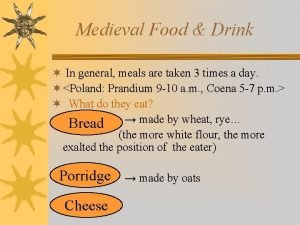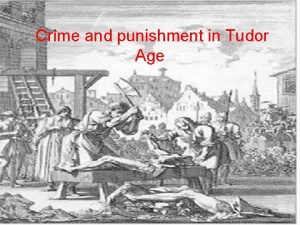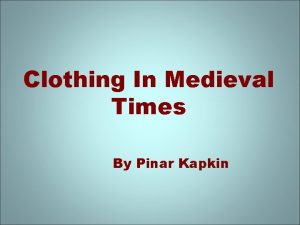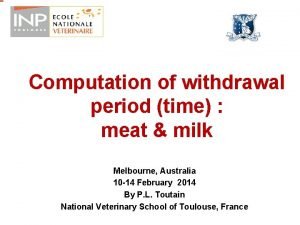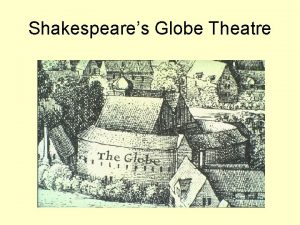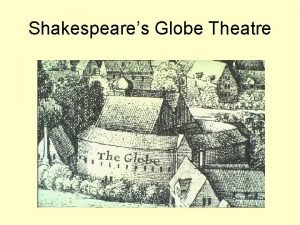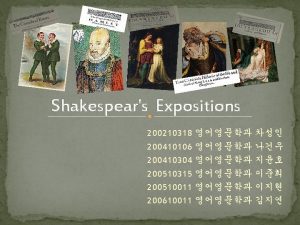Shakespeares Life and Times An Introduction to Shakespeares





















- Slides: 21

Shakespeare’s Life and Times An Introduction to Shakespeare’s Life and the Elizabethan Era

Shakespeare’s Birth and Family �Born on April 23, 1564 �Born in Stratfordupon-Avon, England �His father was a middle-class leather and wood worker. �His family later became well-to-do.

Shakespeare’s Education �Shakespeare started school at age 7. �Attended grammar school until he was about 17 �Never went to university �In grammar school, he would have studied things like Latin, ancient history, and philosophy.

Shakespeare’s Marriage � Shakespeare married Anne Hathaway in 1582. � Her father was rich, so Anne was a catch. � Shakespeare was about 18; Anne was 26. � She was pregnant when they got married. � Shakespeare and Anne had 3 children—Suzannah, and twins, Judith and Hamnet. � Anne lived her whole life in Stratford-upon-Avon. � Shakespeare spent most of the 1590 s in London working in theatre.

While in London… �Shakespeare’s career began as a member of the acting company, The Lord Chamberlain’s Men, which became known as The King’s Men. �The King’s Men became one of the most popular acting companies in London. �In 1590, Shakespeare produced his first play. �Within a few years, Shakespeare became one of the most popular playwright’s in London. �Shakespeare soon became a shareholder in the company, meaning he got a part of their profits. �In 1595, Shakespeare finished Romeo and Juliet. �In 1599, he became a partial owner of The Globe Theater.

While in London… �Shakespeare wrote ~38 plays. �His plays fall into 3 categories: histories, comedies, and tragedies. �Romeo and Juliet is a tragedy. It’s full title is The Tragedy of Romeo and Juliet. �Comedies and tragedies were often fictional. Histories were about real events. �His plays were so popular because he dealt with a wide range of emotions, characters, and knowledge. �He’s responsible for creating phrases that we still use today, like “catch a cold” and “the green-eyed monster. ”

After London… �In 1609, Shakespeare returned to Stratford-upon-Avon and built the largest, fanciest home in town. �In 1612, Shakespeare is widely recognized as England’s most popular writer. �On April 23, 1616, Shakespeare dies at age 54.

Elizabethan England �The era of British history during Queen Elizabeth I’s reign �The “golden age” of British history � Military triumph over Spain � International expansion of British power and culture �The peak of the English Renaissance

The English Renaissance: 1400 -1700 � Renaissance = “rebirth” � The world experienced great advances in the arts and sciences � There were new scientific discoveries like the circulation of blood and planetary motion. � The English Renaissance saw the biggest advances in the arts with great achievements in poetry, music, literature, and theatre. � Renaissance playwrights, especially Shakespeare, created a revolution in British theatre.

Daily Life in Elizabethan England: Not So Glorious � The Plague � Also called the “Black Death” � Killed 60% of the population in some countries � If you had symptoms, you had a 70% chance of dying. �Symptoms: rash, fever, boils, seizures �Affected common people and royalty alike � Caused by rats, fleas, and lice � Common presence in Elizabethan England due to poor sanitation

Daily Life in Elizabethan England: Not All Glorious �Deadly illness was a common part of life. � Medicine was not developed. �The average lifespan was only about 40 years. �If you were born in Elizabethan England, 5% of you would have died in the first week of your life. � 40% of you would not live to see your 15 th birthday. �About 1% of mothers died in childbirth.

Growing Up Elizabethan, or “If you made it through the first week of life…” �When a healthy baby was born, parents would consult astrologers to determine if the baby’s birthday was a fortunate date and time. �Elizabethans thought that their lives were determined ahead of time by God and that their future could be read in the positions of the stars and planets.

Growing Up Elizabethan, or “If you made it through the first week of life…” � Children were treated like miniature versions of adults. � Childhood was not considered a special time of life. � Boys were sent to grammar school, if their parents could afford it. �After school, boys would go find work to make money to help their family survive. �Girls were not usually formally educated. �Girls stayed at home to take care of younger siblings and learn how to run a household.

Growing Up Elizabethan, or “If you made it through the first week of life…” �In the middle and upper classes, marriages were arranged. �Poorer folks had more freedom to choose their marriage partners. This was starting to change a bit in Shakespeare’s time. Some parents took their children’s opinions into account.

The Great Chain of Being �A hierarchy that stretched from the lowest members of society to God �You were not allowed to make incredible jumps from poverty to royalty. �Marrying below your status was looked down on. �This made life very structured upon your class. God Royal Men Royal Women Noble Men Noble Women Middle Class Men Middle Class Women Peasant Men Peasant Women Animals

The Great Chain of Being �Laws were even enacted that told people what color clothing they could wear based on their place in society. Purple Brown Tan Pastels Royal men Royal women Noble women Middle-Class women Peasant women Black White Bright Jewel Tones

More Fun Facts of Elizabethan Life �Elizabethans rarely bathed (only about once a year). �Bathing was thought to spread disease, not prevent it. �They lost most of their teeth by the time they were in their 40 s or 50 s. �You had one or two outfits that you wore everyday. �You had one or two sets of undergarments, which you would only wash if you had that second set.

More Fun Facts of Elizabethan Life �With no baths , Elizabethan England was pretty stinky. �Plus, there was no indoor plumbing. �If you were well-off, you would have a chamber pot to “go” in. You (or maybe a servant) would empty it everyday into the street. �Everyone else had to “go” in a community pit.

An Elizabethan Street in England

How to Have Fun in Elizabethan England Attend a bear-baiting! Or maybe a public hanging or witchburning!

How to Have Fun in Elizabethan England Or go to theater!
 Othello theme of jealousy
Othello theme of jealousy Shakespeares tragedy about racism and jealousy
Shakespeares tragedy about racism and jealousy William shakespeares romeo and juliet
William shakespeares romeo and juliet William shakespeare 1587
William shakespeare 1587 Theme of hamlet
Theme of hamlet Idioms shakespeare
Idioms shakespeare Factors of 168
Factors of 168 When and where was shakespeare born
When and where was shakespeare born Life and times of shakespeare
Life and times of shakespeare The life and times of the ant
The life and times of the ant Shakespeare life and times
Shakespeare life and times City life vocabulary
City life vocabulary Slidetodoc.com
Slidetodoc.com Single life vs married life quotes
Single life vs married life quotes Freetutorical.com harvest land
Freetutorical.com harvest land Thermoplastics can be heated and shaped multiple times.
Thermoplastics can be heated and shaped multiple times. Robert pushes the box to the left
Robert pushes the box to the left Medieval times food and drink
Medieval times food and drink Earthquake p-wave and s-wave travel time graph
Earthquake p-wave and s-wave travel time graph Tudor punishment for stealing
Tudor punishment for stealing What did lords and ladies wear in medieval times
What did lords and ladies wear in medieval times Meat and milk withdrawal times
Meat and milk withdrawal times

















